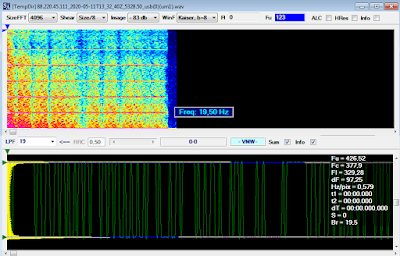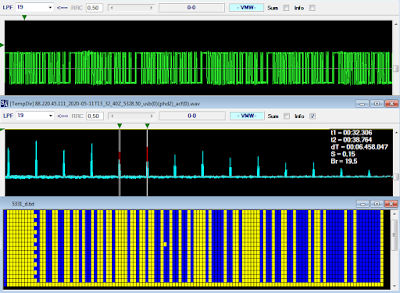(see the previous post for background)
My friend cryptomaster suggested me an interesting way to measure and analyze the two component frequencies of the 200Bd/800 FSK signal by using the VMW module of SA. Indeed, using that tool it is quite possible to obtain additional phase characteristics of the signals. For this, it is necessary to consider the bitmap picture of the carrier signal, adjusting the scan so that one period of the carrier wave fits on the line of the raster. Two columns of red and blue colors on the screen of the WMV module reflect the positive and negative half-cycles of the oscillation (Fig. 1).
My friend cryptomaster suggested me an interesting way to measure and analyze the two component frequencies of the 200Bd/800 FSK signal by using the VMW module of SA. Indeed, using that tool it is quite possible to obtain additional phase characteristics of the signals. For this, it is necessary to consider the bitmap picture of the carrier signal, adjusting the scan so that one period of the carrier wave fits on the line of the raster. Two columns of red and blue colors on the screen of the WMV module reflect the positive and negative half-cycles of the oscillation (Fig. 1).
 |
| Fig. 1 - oscillation period (thanks to cryptomaster) |
Well, it turned out that during the formation of this FSK signal the pahses of the two frequencies are preserved after each "shift" (Figs 2a,2b): that suggests that it's formed by switching (mechanically or electronically) two independent F1 F2 frequency generators which bear some inter-relationships or by using a VCO system.
 |
| Fig. 2a - F1 component phase (on a 2 periods view) |
 |
| Fig. 2b - F2 component phase (on a 3 periods view) |
Phase analysis was performed on a signal recorded in IQ mode exactly on its center fequency of 5094.7 KHz: in this case the two values of the frequency generators are:
F1 ~ 5602,6 HZ (2:0,000356972)
F2 ~ 6402,6 Hz (3:0,000468558)
as expecetd, 800 Hz shift.
Me and cryptomaster discussed these values and he obtained an interesting result recording the signal at a frequency of 5093.50 KHz/usb. In this case, the carriers are equal to F1 = 800Hz F2 = 1600 Hz (Fig. 3).
 |
| Fig. 3 - F1 F2 components (thanks to cryptomaster) |
 |
| Fig. 4 - discrepancy between F1 F2 |












